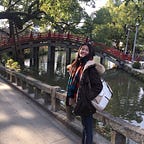The Pursuit of Self Awareness
Two weeks ago, I was on a trip to Kosovo. On my way back, I had a short stopover and visited the Albertina Museum in Vienna. Perhaps due to what I experienced in a peaceful Kosovo, as compared to what had happened from 1998 to 1999 during the Kosovo War, the oeuvre of the Austrian artist Maria Lassnig (1919–2014) in the museum instantly caught my attention with high colors and brushy inquiries into the essence of humanity and one’s inner self.
“The only true reality is my feelings, played out within the confines of my body.”
- Maria Lassnig
Rendering her theory of “body awareness” visible, Lassnig places her own body at the heart of her work — long before physical feelings and body language become the themes of the international avant-garde. For decades, Lassnig’s work did not receive any serious attention. Yet, that didn’t stop her from producing pioneering works that delineate the mental and physical sensations experienced by her body and recreate her observations of different objects on the canvas.
“Again, and again her paintings return us to the acute tension between how we feel ourselves to be — messy, inarticulate, barely there — and how we are increasingly obliged to present ourselves to the world — coherent, persuasive, and whole.”
- Kathryn Hughes (2016)
The extent to which Lassnig explores herself through painting self-portraits and body parts inspires outsiders, like me, to start looking inwards to re-discover oneself, providing a unique opportunity to grow by learning more about ourselves not only from a physical aspect but also at a mental level. This enlightenment gained from body awareness ascertains the possibility of leveling up self-awareness and further re-define one’s relationship to the world.
“You can become aware of your body through pressure, through tension, or by straining one part of it in a particular physical position; in other words, awareness is expressed in sensations of pressure or tension, in sensations of fullness or emptiness, etc. “
- Maria Lassnig
Having been through the Second World War, Lassnig continues to bridge the post-war era and the provocative feminist voices that emerged from the 1960s and 1970s by painting her personal feelings for the surrounding world that she’s living in. Amid today’s turmoil, this realization is, as in the old days, essential for human beings to stay simple and strong, just as Psychologists Shelley Duval and Robert Wicklund (1972) coined
“when we focus our attention on ourselves, we evaluate and compare our current behavior to our internal standards and values.”
With all the possibilities one could take, our vulnerable flesh can be laden with physical or emotional burdens alongside the ups and downs. A loss of one’s dream or core values might never be retrieved once they are gone.
By recognizing the imperatives of feelings and sensations, humans could potentially change their behaviors, including every perspective in life, ranging from thinking to dressing. Keeping self-awareness in mind, one is expected to find peace with yourself within this new realization, be it how we connect to inner ourselves or to the external world. Perhaps, it is also in this pursuit of self-understanding that creates meanings for our lives.
Reference:
- Maria Lassnig: under the skin
- What is Self-Awareness and Why is it Important? [+5 Ways to Increase It]
Words: Katy Yang (Oct. 29, 2019)
This article is also published on Kontrast’s website. For more insightful articles, please refer to Kontrast Journal.
